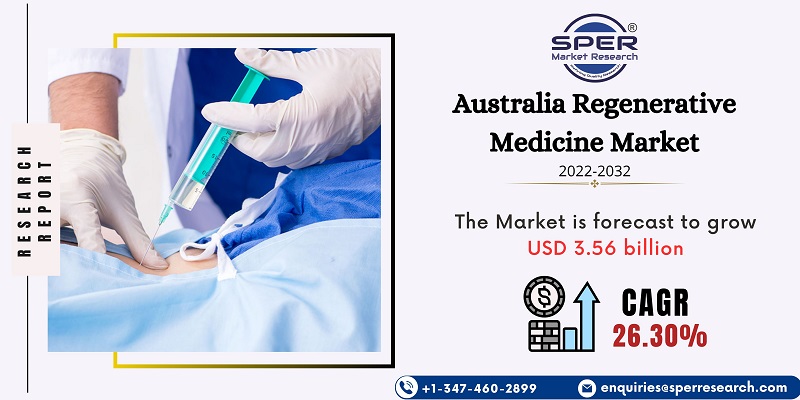
Australia Regenerative Medicine Market Growth, Size, Trends, Demand, Revenue and Future Share
Australia Regenerative Medicine Market Size- By Type, By Application, By End User- Regional Outlook, Competitive Strategies and Segment Forecast to 2033
| Published: Sep-2023 | Report ID: PHAR2313 | Pages: 1 - 102 | Formats*: |
| Category : Pharmaceutical | |||
- AbbVie purchased Allergan in 2020 in order to expand its product portfolio in immunology, hematologic cancer, neurology, and Allergan aesthetics.
- MiMedx will offer Axiofill, an Extracellular Matrix (ECM) Particulate product produced from human placental tissue, in 2022. Axiofill is a particulate product generated from human placenta that is used in surgical recovery procedures.
-007184213092023.jpg)

| Report Metric | Details |
| Market size available for years | 2019-2033 |
| Base year considered | 2022 |
| Forecast period | 2023-2033 |
| Segments covered | By Type, By Application, By End User |
| Regions covered | Eastern Region, Southern Region, Western Region, Northern Region |
| Companies Covered | Avita Medical Limited, Capricor Therapeutics Limited, Cellmid Limited, Cynata Therapeutics Inc., Cynata Therapeutics Limited, Healius Limited, Mesoblast Limited, Orthocell Limited |
- Researchers and Scientists
- Pharmaceutical and Biotechnology Companies
- Healthcare Providers
- Academic and Medical Institutio
| By Type: |
|
| By Application: |
|
| By End User: |
|
- Australia Regenerative Medicine Market Size (FY’2023-FY’2033)
- Overview of Australia Regenerative Medicine Market
- Segmentation of Australia Regenerative Medicine Market By Type (Cell Therapy, Gene Modification, Tissue Engineering, Others)
- Segmentation of Australia Regenerative Medicine Market By Application (Bone Graft Substitute, Osteoarticular Disease, Dermatology, Cardiovascular Diseases, Others)
- Segmentation of Australia Regenerative Medicine Market By End User (Academic, Commercial)
- Statistical Snap of Australia Regenerative Medicine Market
- Expansion Analysis of Australia Regenerative Medicine Market
- Problems and Obstacles in Australia Regenerative Medicine Market
- Competitive Landscape in the Australia Regenerative Medicine Market
- Impact of COVID-19 and Demonetization on Australia Regenerative Medicine Market
- Details on Current Investment in Australia Regenerative Medicine Market
- Competitive Analysis of Australia Regenerative Medicine Market
- Prominent Players in the Australia Regenerative Medicine Market
- SWOT Analysis of Australia Regenerative Medicine Market
- Australia Regenerative Medicine Market Future Outlook and Projections (FY’2023-FY’2033)
- Recommendations from Analyst
1.1. Scope of the report1.2. Market segment analysis
2.1. Research data source
2.1.1. Secondary Data2.1.2. Primary Data2.1.3. SPER’s internal database2.1.4. Premium insight from KOL’s
2.2. Market size estimation
2.2.1. Top-down and Bottom-up approach
2.3. Data triangulation
4.1. Driver, Restraint, Opportunity and Challenges analysis
4.1.1. Drivers4.1.2. Restraints4.1.3. Opportunities4.1.4. Challenges
4.2. COVID-19 Impacts of the Australia Regenerative Medicine Market
5.1. SWOT Analysis
5.1.1. Strengths5.1.2. Weaknesses5.1.3. Opportunities5.1.4. Threats
5.2. PESTEL Analysis
5.2.1. Political Landscape5.2.2. Economic Landscape5.2.3. Social Landscape5.2.4. Technological Landscape5.2.5. Environmental Landscape5.2.6. Legal Landscape
5.3. PORTER’s Five Forces
5.3.1. Bargaining power of suppliers5.3.2. Bargaining power of buyers5.3.3. Threat of Substitute5.3.4. Threat of new entrant5.3.5. Competitive rivalry
5.4. Heat Map Analysis
6.1. Australia Regenerative Medicine Market Manufacturing Base Distribution, Sales Area, Product Type6.2. Mergers & Acquisitions, Partnerships, Product Launch, and Collaboration in Australia Regenerative Medicine Market
7.1. Australia Regenerative Medicine Market Value Share and Forecast, By Type, 2023-20337.2. Cell Therapy7.3. Gene Modification7.4. Tissue Engineering7.5. Others
8.1. Australia Regenerative Medicine Market Value Share and Forecast, By Application, 2023-2033
8.2. Bone Graft Substitutes8.3. Osteoaticular Diseases8.4. Dermatology8.5. Cardiovascular Diseases8.6. Others
9.1. Australia Regenerative Medicine Market Value Share and Forecast, By End User, 2023-20339.2. Academic9.3. Commercial
10.1. Australia Regenerative Medicine Market Size and Market Share
11.1. Australia Regenerative Medicine Market Size and Market Share By Type (2019-2026)11.2. Australia Regenerative Medicine Market Size and Market Share By Type (2027-2033)
12.1. Australia Regenerative Medicine Market Size and Market Share By Application (2019-2026)12.2. Australia Regenerative Medicine Market Size and Market Share By Application (2027-2033)
13.1. Australia Regenerative Medicine Market Size and Market Share By End User (2019-2026)13.2. Australia Regenerative Medicine Market Size and Market Share By End User (2027-2033)
14.1. Australia Regenerative Medicine Market Size and Market Share By Region (2019-2026)14.2. Australia Regenerative Medicine Market Size and Market Share By Region (2027-2033)14.3. Eastern Region14.4. Southern Region14.5. Western Region14.6. Norther Region
15.1. Avita Medical Limited
15.1.1. Company details15.1.2. Financial outlook15.1.3. Product summary15.1.4. Recent developments
15.2. Capricor Therapeutics Limited
15.2.1. Company details15.2.2. Financial outlook15.2.3. Product summary15.2.4. Recent developments
15.3. Cellmid Limited
15.3.1. Company details15.3.2. Financial outlook15.3.3. Product summary15.3.4. Recent developments
15.4. Cynata Therapeutics Inc.
15.4.1. Company details15.4.2. Financial outlook15.4.3. Product summary15.4.4. Recent developments
15.5. Cynata Therapeutics Limited
15.5.1. Company details15.5.2. Financial outlook15.5.3. Product summary15.5.4. Recent developments
15.6. Healius Limited
15.6.1. Company details15.6.2. Financial outlook15.6.3. Product summary15.6.4. Recent developments
15.7. Mesoblast Limited
15.7.1. Company details15.7.2. Financial outlook15.7.3. Product summary15.7.4. Recent developments
15.8. Orthocell Limited
15.8.1. Company details15.8.2. Financial outlook15.8.3. Product summary15.8.4. Recent developments
15.9. Others
SPER Market Research’s methodology uses great emphasis on primary research to ensure that the market intelligence insights are up to date, reliable and accurate. Primary interviews are done with players involved in each phase of a supply chain to analyze the market forecasting. The secondary research method is used to help you fully understand how the future markets and the spending patterns look likes.
The report is based on in-depth qualitative and quantitative analysis of the Product Market. The quantitative analysis involves the application of various projection and sampling techniques. The qualitative analysis involves primary interviews, surveys, and vendor briefings. The data gathered as a result of these processes are validated through experts opinion. Our research methodology entails an ideal mixture of primary and secondary initiatives.



Frequently Asked Questions About This Report
PLACE AN ORDER
Year End Discount
Sample Report
Pre-Purchase Inquiry
NEED CUSTOMIZATION?
Request CustomizationCALL OR EMAIL US
100% Secure Payment






Related Reports
Our Global Clients
Our data-driven insights have influenced the strategy of 200+ reputed companies across the globe.




















